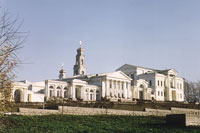 Yekaterinburg today is a beautiful city. The present day Ekaterinburg is rich in sights - architectural monuments
of Russian classicism of the 18-19th centuries including the estate of
Rastorguev ¢ Kharitonov - a pearl of the regional centre.
Yekaterinburg today is a beautiful city. The present day Ekaterinburg is rich in sights - architectural monuments
of Russian classicism of the 18-19th centuries including the estate of
Rastorguev ¢ Kharitonov - a pearl of the regional centre.SIGHTSEEING. PLACES TO VISIT IN YEKATERINBURG.
The city has a unique appearance. It
seems that history itself is embodied in its streets and avenues, architectural
ensembles and sights. More than 600 monuments of history and culture are located
in the city, and 43 of them are considered to be top national monuments because
of their special significance.
The heart of Yekaterinburg is its dam (Plotinka), that permitted the
initial development of the city's industrial base. The dam was erected in 1723
and survived later two reconstructions. At present it is an impressive
industrial monument of the 18th century.
 Yekaterinburg today is a beautiful city. The present day Ekaterinburg is rich in sights - architectural monuments
of Russian classicism of the 18-19th centuries including the estate of
Rastorguev ¢ Kharitonov - a pearl of the regional centre.
Yekaterinburg today is a beautiful city. The present day Ekaterinburg is rich in sights - architectural monuments
of Russian classicism of the 18-19th centuries including the estate of
Rastorguev ¢ Kharitonov - a pearl of the regional centre.
The house of the Balandins. Before revolution it housed port back election meeting. Various balls, feasts and receptions were given there.
Many churches and chapels made the city's panorama very beautiful and picturesque. In the beginning of the 20th century there were about 50 churches, and of this number only 6 still remain today.
The Church of Alexander Nevsky - the major cathedral of the Novo-Tihvinsky nunnery ¢ was built in honour of the heroes of the 1812 war against Napoleon. In Soviet period it preserved its outside beauty, but was completely changed inside and housed the Nature Department of the Regional Studies Museum. Nowadays it belongs to the eparchy.
The Novo-Tihvinsky nunnery started as a church in 1782 and by 1913 it became one of the biggest in Russia with 900 novices. In the Soviet times it was altered into a hospital. Nowadays it belongs to the eparchy.
The Church of Saint Trinity was laid down in 1818 by old-believersÆ community. In 1930 the temple was closed and only in 1990 returned to the church. Nowadays itÆs the major temple of the Yekaterinburg eparchy.
The Church of the of the Ascension is the oldest of the survived. It used to keep some HermitageÆs treasured in the WWII and was a converted into a Regional Studies Museum.
Probably the main tourist attraction though is the spot where the Romanovs dynasty met its final gruesome end! The Church on blood has been recently constructed to mark the site and pay a tribute to the last royal family.
There are also quite a few buildings in the constructivist style in the city. Typical of this style are such examples as the Main Post Office, the "Uralski Rabochi" printing house, the film studio, the famous White Tower, the "Dynamo" stadium, etc.
The Soviet Period brought new trends to Ekaterinburg's architecture: luxury and rationalism, which reflected the influence of both ideology and asceticism. New tendencies in the development of world architecture have also affected the city. Some of the most well known of these structures include the Military Headquarters, the Urals State Technical University (UPI), the Railway Administrative Building, and the Philharmonic Society.
The dynamics of
contemporary life does have its effect on the city. However, good care of its
cultural heritage helps to maintain the historical continuity of times and
confirms the right of Ekaterinburg to the status of a historical city.